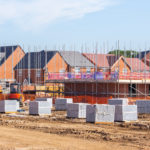Are we building homes for the sake of building? Dr Anna Pagani, Senior Lecturer at King’s College London, discusses how a housebuilding moratorium could provide the homes we actually need.
The severity of the UK’s housing crisis is acknowledged by most of the political spectrum. However, despite ambitious housebuilding targets being set by different governments over the years, the share of social housing — a crucial vehicle for good quality, affordable accommodation — has nearly halved (from 31% in 1979 to 16% in 2023).
Furthermore, housebuilding has ecological consequences — it harms biodiversity, increases emissions, and moves the UK further away from its carbon reduction commitments.
The real question, then, is not whether we need more and better-quality affordable homes, but whether continuous housebuilding is a path to achieving that goal in a way that remains compatible within ecological limits. Overwhelming scientific evidence says the answer is no.
If not through growth, then, how can we respond to the housing crisis and better safeguard the planet?

Mapping systemic issues
To answer this question, in the framework of a research project on housing justice, we involved London-based English housing associations in using systems thinking to look beneath the surface of the housing crisis — the ‘tip of the iceberg’ — to explore the deeper patterns, structures, and beliefs that have shaped it over time.
Our system maps help visualise the counterintuitive structures that underpin the provision of social rented homes — particularly the sector’s reliance on market-rate housing construction to cross-subsidise social housing. This creates a cycle where estate redevelopment is prioritised as a way to maintain existing homes, but delays and limited resources increase dependency on building new homes instead. The consequences include a shrinking supply of good-quality social rented homes, the physical and emotional displacement of residents, and growing pressures on both staff and housing association finances.
Using the systems map, we presented housing associations with a challenge: What if there was a building moratorium across the housing sector? What would the impact on the social housing system be?
A housebuilding moratorium
Moratoria are established planning tools used to suspend harmful activities — such as soil sealing, infrastructure expansion, and fossil fuel extraction.
In a workshop, the housing associations discussed the opportunities and obstacles to a housebuilding moratorium. These included the need to rethink their dependence on a cross-subsidy financial model of housing provision, to address the quantity, quality, and adequacy of the existing stock, to factor projections of population growth into housing stock requirements, to consider the geographical distribution of residents and homes, as well as the strengths and weaknesses of existing architecture and planning solutions.
Based on the workshop discussions, our system maps, and on secondary data available from reports and scientific publications, our study proposed a list of key conclusions on what a moratorium could potentially do.
1) A moratorium could challenge the nature of the housing crisis
Our findings don’t question whether there is a housing crisis, but how this crisis has been conceptualised. Supply has outpaced demand across England since 1996, and its construction has a marginal effect on house prices. Meanwhile, recent studies estimate that there are 1.5 million unoccupied dwellings in England —including vacant and second homes. These are not confined to remote areas only; data from a recent report have identified the City of London, Camden, and Kensington and Chelsea among the local authorities containing ‘ghost enclaves’ (at least 25% of properties empty or largely unoccupied). Altogether, only about half of the bedrooms in England are used to meet housing needs, with about 19% of the housing stock having more than two extra bedrooms — raising critical questions about the just distribution of space.
In this landscape, housing targets are set, in participants’ words, ‘arbitrarily’, to achieve growth, rather than justice — a goal materialised through strategies mainly supporting investment-led consumption.
2) A moratorium could prompt the implementation of innovative solutions
Many national and international examples of providing housing within the existing housing stock already exist, and range from design, planning, and management.
As for empty homes, a possible solution is to exempt homeowners from paying Capital Gains Tax when selling for social rent, a Community Right to Buy, and stronger regulations to identify and limit the proliferation of empty homes. New models of multigenerational and intergenerational housing could support a better space redistribution across the whole housing sector.

Furthermore, maintaining rather than demolishing the existing housing stock has been shown to be socially, environmentally and economically better. A moratorium would be a clear opportunity to reimagine the role of the built environment professional engaged in what Malterre-Barthes calls “unbuilding, reparative work”, such as urban mining, de-sprawl, upcycling, along with new jobs accommodating radical new ways of working.
Beyond innovative ways to think of how to use the existing housing stock, innovation would also need to happen around the business model that has underpinned social housing provision since the 1980s. Breaking the self-perpetuating cycle of investment in property could start from land ownership; permanent social cooperatives, community land trusts are already demonstrating how to retain rather than capture the social and use value of land. It would also require alternative measures of “value creation”, accounting for long-term, cross-sectoral benefits of housing—prioritising health and wellbeing for all within planetary boundaries.

3) A moratorium would depend on and contribute to transformation across society
Halting construction in an unchanged paradigm of unquestioned growth could lead to several negative consequences, including transforming offices into poor-quality homes (permitted development rights), displacement of residents through profit-driven retrofit (eco-gentrification), or taxes on extra spaces affecting the most vulnerable residents (bedroom tax). A moratorium would need to be supported by changes in the growth-oriented worldviews and narratives that orchestrate housing markets and, more broadly, society. In parallel, as shown by this study, it could support reflections on where systemic changes are needed.
In this context, systems thinking could guide all of us in questioning assumptions around the causes and consequences of continuous construction, on its purpose and outcome, and on the conditions of systemic transformation needed to start building again.
Be less scared of radical change
As global calls to halt the growth in construction gain momentum, there is an urgent need to question housebuilding targets and collectively redesign the relationship between housing needs and housing delivery.
This process is already underway. Feedback from workshop participants revealed how systems thinking encouraged them to ‘disrupt how we do things’, ‘reflect on the received wisdom that drives much decision-making’ and ‘be less scared of radical change’. At the same time, sustained effort is needed to contribute to and support alternative models to the growth-driven mechanisms relentlessly undermining the provision of housing for all, within planetary boundaries.
Header image ©ceebeestock/AdobeStock










